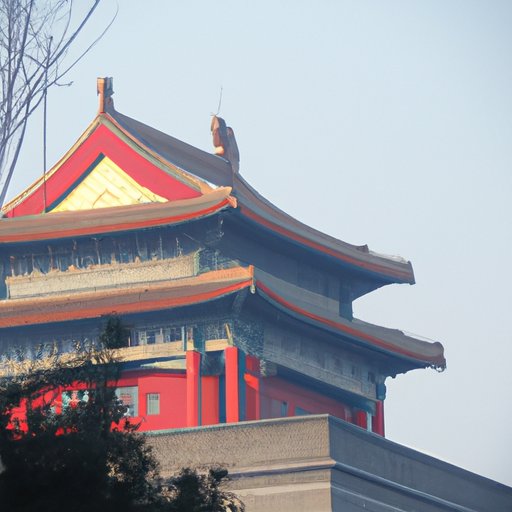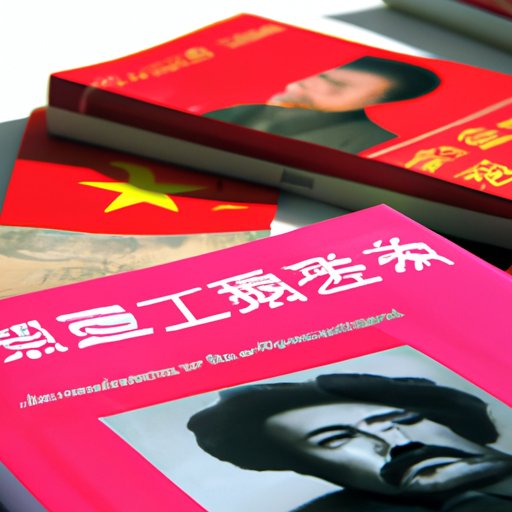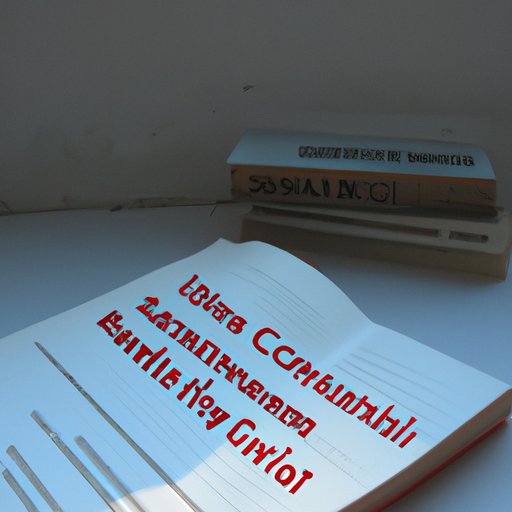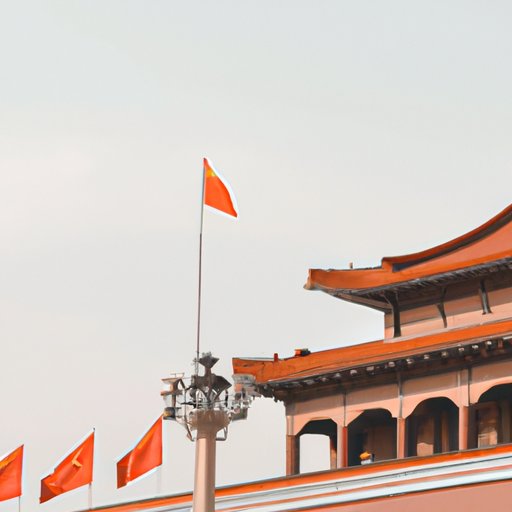Introduction
The Cultural Revolution was a period of immense political, economic and social turmoil in China that lasted from 1966 to 1976. The purpose of this article is to explore how this tumultuous period ended, as well as to assess the long-term legacy of the Cultural Revolution on China. This article will examine the political causes of the Cultural Revolution’s end, analyze the impact of Mao Zedong’s death on the Cultural Revolution’s conclusion, explore how China rebuilt itself after the Cultural Revolution, highlight key figures in the Cultural Revolution and their role in its end, assess the economic costs of the Cultural Revolution and its end, discuss the social changes in China following the Cultural Revolution, and evaluate the long-term legacy of the Cultural Revolution.
Examining the Political Causes of the Cultural Revolution’s End
The Cultural Revolution was brought to an end by a combination of political factors, most notably the declining health and eventual death of Mao Zedong, the leader of the Chinese Communist Party (CCP) and the architect of the Cultural Revolution. The role of Deng Xiaoping, the Gang of Four and other key figures in the Cultural Revolution’s conclusion will also be discussed.
Mao Zedong’s Declining Health and Death
Mao Zedong was the leader of the CCP and the driving force behind the Cultural Revolution. When his health began to decline in 1974, it became clear that his ability to lead the Cultural Revolution was fading. In 1976, Mao passed away, marking the end of the Cultural Revolution. His death provided an opportunity for reformers within the CCP to take control of the government and begin the process of rebuilding China.
Role of Deng Xiaoping in Ending the Cultural Revolution
Deng Xiaoping was a key figure in the CCP and a prominent reformer. After Mao’s death in 1976, Deng emerged as the leader of the reform faction within the CCP. He worked to end the Cultural Revolution and introduce reforms that would modernize China’s economy and open the country up to the rest of the world. By 1978, he had consolidated power within the CCP and began the process of rebuilding China.
Impact of the Gang of Four
The Gang of Four was a group of radical Maoists led by Jiang Qing, Mao’s third wife. They were staunch supporters of the Cultural Revolution and opposed any attempts at reform. After Mao’s death, they sought to maintain their grip on power within the CCP. However, they were eventually arrested in 1976 and put on trial in 1981, effectively ending their influence over the party.
Analyzing the Impact of Mao Zedong’s Death on the Cultural Revolution’s Conclusion
Mao Zedong’s death in 1976 marked the end of the Cultural Revolution and the beginning of a new era in Chinese politics. His death created a power vacuum within the CCP, leading to a struggle between reformers like Deng Xiaoping and hardliners like Hua Guofeng, Mao’s designated successor. In the end, Deng emerged victorious and began the process of rebuilding China.
Examination of the Power Struggle Between Deng Xiaoping and Hua Guofeng
In the aftermath of Mao’s death, a power struggle ensued between two of his designated successors: Deng Xiaoping and Hua Guofeng. Deng was a prominent reformer who sought to end the Cultural Revolution and introduce reforms that would modernize China’s economy. On the other hand, Hua was a hardliner who sought to maintain the status quo and preserve Mao’s legacy. In the end, Deng emerged victorious and assumed control of the CCP.
Assessment of the Implications of Mao’s Death for the Cultural Revolution
Mao Zedong’s death marked the end of the Cultural Revolution and the beginning of a new era in Chinese politics. With Mao gone, reformers like Deng Xiaoping had an opportunity to take control of the CCP and begin the process of rebuilding China. This marked the end of the Cultural Revolution and ushered in a new period of reform and modernization that would transform China into the global power it is today.

Exploring How China Rebuilt Itself After the Cultural Revolution
After the Cultural Revolution, China embarked on a path of reform and economic recovery. The Chinese government introduced a series of economic reforms designed to modernize China’s economy and open it up to the rest of the world. These reforms included the liberalization of prices and foreign investment, the decentralization of state-owned enterprises, and the introduction of market-oriented policies. These reforms helped to spur economic growth and laid the foundation for China’s emergence as a global superpower.
Introduction of Reform Policies
In the wake of the Cultural Revolution, the Chinese government embarked on a program of economic reform. The goal of these reforms was to create a more efficient and market-oriented economy. To achieve this goal, the government liberalized prices and foreign investment, decentralized state-owned enterprises, and introduced market-oriented policies. These reforms helped to spur economic growth and lay the foundation for China’s emergence as a global superpower.
Economic Recovery Initiatives
In addition to introducing economic reforms, the Chinese government also undertook a series of initiatives designed to spur economic recovery. These initiatives included the establishment of special economic zones, the promotion of foreign trade and investment, and the implementation of fiscal and monetary policies aimed at stimulating economic growth. These measures helped to revive China’s economy and set the stage for its emergence as a global economic powerhouse.
Social Changes Following the Cultural Revolution
The Cultural Revolution had a profound effect on Chinese society. In its aftermath, the Chinese government enacted a series of reforms designed to promote social stability and economic prosperity. These reforms included the introduction of free education, the expansion of healthcare coverage, and the promotion of gender equality. These measures helped to improve the lives of ordinary Chinese citizens and laid the groundwork for a more prosperous and equitable society.

Highlighting Key Figures in the Cultural Revolution and Their Role in Its End
The Cultural Revolution was a complex period in Chinese history that was shaped by a variety of different forces. This section will profile some of the key figures in the Cultural Revolution and discuss their role in its end.
Profile of Deng Xiaoping
Deng Xiaoping was one of the most influential figures in the Cultural Revolution. He was a prominent reformer who sought to end the Cultural Revolution and introduce reforms that would modernize China’s economy. After Mao’s death in 1976, Deng emerged as the leader of the reform faction within the CCP and assumed control of the government. He then embarked on a program of economic reform and modernization that helped to transform China into the global power it is today.
Analysis of the Gang of Four
The Gang of Four was a group of radical Maoists led by Jiang Qing, Mao’s third wife. They were staunch supporters of the Cultural Revolution and opposed any attempts at reform. After Mao’s death, they sought to maintain their grip on power within the CCP. However, they were eventually arrested in 1976 and put on trial in 1981, effectively ending their influence over the party.
Evaluation of the Contributions of Other Key Figures
In addition to Deng Xiaoping and the Gang of Four, a number of other key figures played an important role in the Cultural Revolution and its conclusion. These figures include Hua Guofeng, Mao’s designated successor; Hu Yaobang, a reformer who sought to introduce democratic reforms in China; and Zhao Ziyang, who served as General Secretary of the CCP from 1987 to 1989. Each of these figures contributed to the end of the Cultural Revolution in their own way.

Assessing the Economic Costs of the Cultural Revolution and its End
The Cultural Revolution had a devastating effect on China’s economy. The disruption caused by the Cultural Revolution resulted in severe economic hardship for many Chinese citizens. In addition, the economic reforms implemented in the aftermath of the Cultural Revolution had a long-term impact on the Chinese economy. This section will assess the economic costs of the Cultural Revolution and its end.
Evaluation of the Impact on Chinese Industry and Agriculture
The Cultural Revolution had a devastating effect on Chinese industry and agriculture. Industrial output declined drastically during the Cultural Revolution, resulting in severe shortages of food and other essential goods. Agricultural production was also disrupted, resulting in reduced yields and food insecurity. These effects had a long-lasting impact on China’s economy.
Discussion of the Long-Term Economic Effects of the Cultural Revolution
The economic reforms implemented in the aftermath of the Cultural Revolution had a long-term impact on the Chinese economy. The reforms increased efficiency, spurred economic growth, and opened the country up to foreign investment. These reforms helped to transform China into an economic superpower, but also led to increased inequality and environmental degradation. As such, the long-term economic effects of the Cultural Revolution are still being felt today.
Discussing the Social Changes in China Following the Cultural Revolution
The Cultural Revolution had a profound effect on Chinese society. This section will discuss the social unrest and violence that occurred during the Cultural Revolution, as well as the long-term social effects of the Cultural Revolution.
Overview of the Great Proletarian Cultural Revolution
The Cultural Revolution was a period of immense political, economic and social upheaval in China that lasted from 1966 to 1976. During this time, the Chinese government launched a series of campaigns aimed at transforming Chinese society and eliminating perceived enemies of the state. These campaigns led to widespread social unrest, violence, and economic disruption.
Analysis of the Social Unrest and Violence During the Cultural Revolution
The Cultural Revolution was characterized by widespread social unrest and violence. Millions of Chinese citizens were persecuted, arrested or killed as a result of the government’s campaigns. Universities and schools were closed, cultural and religious sites were destroyed, and many traditional practices were outlawed. These measures had a profound effect on Chinese society.
Assessment of the Long-Term Social Effects of the Cultural Revolution
The Cultural Revolution had a lasting effect on Chinese society. Many of the social changes that occurred during the Cultural Revolution remain in place today, including increased gender equality, improved access to education, and greater social mobility. In addition, the Cultural Revolution led to a renewed focus on science and technology, which has helped to propel China into the 21st century.
Evaluating the Long-Term Legacy of the Cultural Revolution
The Cultural Revolution had a profound effect on China that is still being felt today. This section will discuss the political, economic and social reforms that followed the Cultural Revolution, as well as the lasting impact of the Cultural Revolution on China.
Discussion of the Political, Economic and Social Reforms That Followed the Cultural Revolution
In the aftermath of the Cultural Revolution, the Chinese government introduced a series of political, economic and social reforms. These reforms included the liberalization of prices and foreign investment, the decentralization of state-owned enterprises, the introduction of market-oriented policies, the establishment of special economic zones, the promotion of foreign trade and investment, and the implementation of fiscal and monetary policies aimed at stimulating economic growth. These reforms helped to spur economic growth and set the stage for China’s emergence as a global superpower.
Analysis of the Lasting Impact of the Cultural Revolution on China
The Cultural Revolution had a lasting impact on China that is still being felt today. The economic reforms implemented in the aftermath of the Cultural Revolution helped to transform China into an economic superpower, but also led to increased inequality and environmental degradation. In addition, the Cultural Revolution had a profound effect on Chinese society, leading to increased gender equality, improved access to education, and greater social mobility. As such, the long-term legacy of the Cultural Revolution can still be seen in China today.
Conclusion
The Cultural Revolution was a period of immense political, economic and social turmoil in China that lasted from 1966 to 1976. This article explored how the Cultural Revolution ended, as well as its long-term political, economic and social costs. It examined the role of Mao Zedong’s death in the conclusion of the revolution, as well as the contributions of Deng Xiaoping, the Gang of Four and other key figures. It also explored how China rebuilt itself after the Cultural Revolution, assessed the economic costs of the Cultural Revolution and its end, and evaluated the long-term legacy of the Cultural Revolution. The Cultural Revolution had a profound effect on China that is still being felt today, and its legacy will continue to shape the country for years to come.
(Note: Is this article not meeting your expectations? Do you have knowledge or insights to share? Unlock new opportunities and expand your reach by joining our authors team. Click Registration to join us and share your expertise with our readers.)
